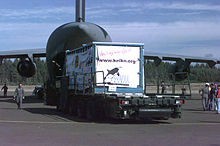Transportation of animals: Difference between revisions
| Line 45: | Line 45: | ||
==History== |
==History== |
||
Two famous historical examples of animal transportation are [[Hanno (elephant)|Hanno]] the elephant<ref>{{cite book | last=Bedini |first=Silvano A. |title=The Pope's Elephant | publisher= Carcanet Press |location=Manchester |isbn=1-85754-277-0 }}</ref> and [[Dürer's Rhinoceros]]<ref>{{cite book |last=Clarke |first=T. H. |authorlink= |coauthors= |title=The Rhinoceros from Dürer to Stubbs: 1515–1799 | year=1986 |publisher=Sotheby's Publications |location=London |isbn=0-85667-322-6 }} Chapter 1.</ref> |
Two famous historical examples of animal transportation are [[Hanno (elephant)|Hanno]] the elephant<ref>{{cite book | last=Bedini |first=Silvano A. |title=The Pope's Elephant | publisher= Carcanet Press |location=Manchester |isbn=1-85754-277-0 }}</ref> and [[Dürer's Rhinoceros]].<ref>{{cite book |last=Clarke |first=T. H. |authorlink= |coauthors= |title=The Rhinoceros from Dürer to Stubbs: 1515–1799 | year=1986 |publisher=Sotheby's Publications |location=London |isbn=0-85667-322-6 }} Chapter 1.</ref> |
||
==See also== |
==See also== |
||
Revision as of 11:55, 7 July 2013
An editor has nominated this article for deletion. You are welcome to participate in the deletion discussion, which will decide whether or not to retain it. |

Animal transportation is the movement of animals by transport. Common categories of animals which are transported include livestock destined for sale or slaughter; zoological specimens; laboratory animals; race horses; pets; and wild animals being rescued or relocated. Methods of transporting animals vary greatly from species to species.
The transport of animals is regulated in many countries. In the UK, a Transport of Animals Act was passed in 1906, and now such transport is regulated by directives of the European Union.
The Animal Transportation Association was formed in 1976 by interested parties to develop best practises and provide information to those involved in the shipment of animals.
Livestock

Livestock destined for sale or slaughter, race horses, and pets are frequently transported. It is important to avoid injury and death of the animal.[1]
Research animals
The Institute for Laboratory Animal Research of the United States National Research Council has produced guidelines for the transportation of research animals.[2]
Zoo animals
Wild animals are often transported for display in zoos. Some wild animals offer specific challenges.
Giraffes

Giraffes are typically transported in custom-built containers or crates to account for their height.[3]
In 2013, Nakuru, a 15-month-old female giraffe, was transported from New Zealand to Melbourne in Australia. Her specialised 4.2 metre crate was transported by sea on a cargo ship. As is required by Australian law, Nakaru was quarantined for 30 days at the Werribee Open Range Zoo before being moved again by truck to Melbourne Zoo approximately 30 kilometres away.[4]
Earlier in 2013, Tonda, a 4.3 metre, three-year-old adult male, was moved from Paignton Zoo to Chessington Zoo, both in England. The 322 kilometre move was completed by a Dutch company that specialises in animal transportation using a specially built trailer with an adjustable roof.[3]
Tapirs
Tapirs are odd-toed ungulates, related to the horse and rhinoceros, but are very large animals – the Malayan tapir can grow up to 8 feet long, for example. They are regulated as pachyderms by the United States Department of Agriculture for transportation and import purposes.[5]
Aquarium animals
There are two techniques for moving large marine mammals - wet transit, in which the animal is kept in a large tank of water, and dry transit, in which the animal is placed in a padded sling and kept calm, wet and cool by human assistance. The decision whether to use wet or dry transit will depend on the size of the animal being transported and the distance they need to travel.[6]
Killer Whales

The transportation of killer whales or orca was a key feature of the popular film Free Willy. Keiko, who played the role of Willy in the film, was moved using a trailer - although when he was actually transported to the Oregon Coast Aquarium, he was airlifted by the United Parcel Service. When he was transported to the to the Westman Islands in Iceland in 1998, he was loaded onto a U.S. Air Force C-17 transport.[7]
Seals
Transporting seals is considered to be easier than transporting cetaceans, since seals are semiaquatic and able to tolerate long periods out of water, as long as they are kept cool and moist.[8] In fact, the transportation of seals in water-filled containers is dangerous, and can cause drowning of the animal.[citation needed]
History
Two famous historical examples of animal transportation are Hanno the elephant[9] and Dürer's Rhinoceros.[10]
See also
References
- ^ "Agricultural Research Council". Arc.agric.za. Retrieved 2013-07-01.
- ^ National Research Council (US) Committee on Guidelines for the Humane Transportation of Laboratory Animals (2006). Guidelines for the Humane Transportation of Research Animals. Washington, DC: National Academies Press.
- ^ a b Paignton Zoo giraffe's Chessington move aided by special trailer (BBC News, 10 January 2013)
- ^ Rough trip fails to shake Nakuru by Stephen Cauchi (The Age, 20 April 2013)
- ^ Tapir (Tapiridae) Care Manual (AZA Tapir Taxon Advisory Group, 2013)
- ^ "How Do You Transport a Whale?". Mental Floss. 2010-03-06. Retrieved 2013-07-02.
- ^ "The History of Keiko, the World's Most Famous Whale". Keiko.com. 2003-12-12. Retrieved 2013-07-02.
- ^ "CRC Handbook of Marine Mammal Medicine: Health, Disease, and Rehabilitation - Google Books". Books.google.co.uk. Retrieved 2013-07-01.
- ^ Bedini, Silvano A. The Pope's Elephant. Manchester: Carcanet Press. ISBN 1-85754-277-0.
- ^ Clarke, T. H. (1986). The Rhinoceros from Dürer to Stubbs: 1515–1799. London: Sotheby's Publications. ISBN 0-85667-322-6.
{{cite book}}: Cite has empty unknown parameter:|coauthors=(help) Chapter 1.
Further reading
- Excellence in Animal Transportation, Animal Transportation Association, 1999
- Technical Large Animal Emergency Rescue, John Wiley & Sons, 2009, ISBN 9780813806488
